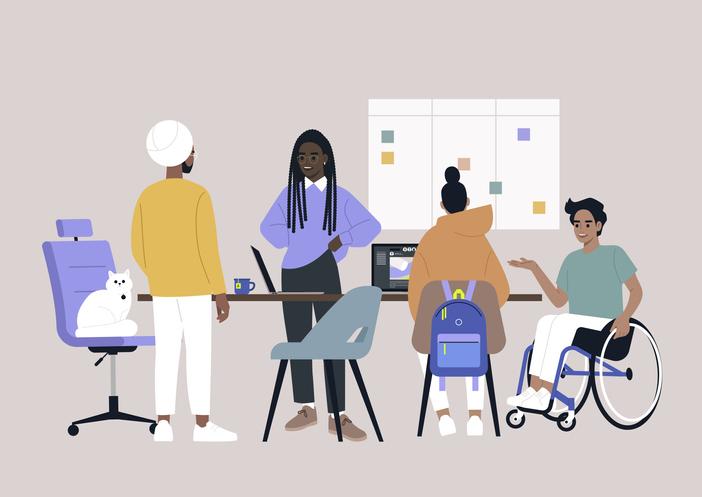
We need an integrated approach to inclusion in higher education
Carol Evans makes the case for an Integrated Inclusion Framework, which would harmonise competing but overlapping EDI agendas to create aligned change that benefits everyone

Demand for higher education is rising in almost every part of the world, and associated with this is the increasing diversity of those entering HE. While inclusion is a key priority for HE providers for moral, ethical, legal and performative reasons, current approaches to equity, diversity and inclusion (EDI) are often exclusive and inefficient. Consequently, the experiences of many of those who find themselves marginalised within HE are poor.
In 2022, the Disability Inclusion Institutional Framework (DIIF) was created from an extensive systematic review of the literature predicated on two core concerns. First, the need to foreground disability because of the lack of attention given to it, and second, to mainstream disability inclusion in HE. In developing the DIIF it became clear that it had considerable potential as a universal inclusion framework because its recommendations align closely with those identified for other disadvantaged groups in higher education.
- Work ‘with’ not ‘on’: making social research more inclusive for LGBT+ people
- Raising aspirations: lessons in running a young scholars programme
- Tips for universities on delivering effective EDI degree programmes
The rationale for an initial focus on disability in HE is hard to dispute. A snapshot of UK data looking at disabled staff and students’ experiences of HE shows that disability is under-represented in policy exchange initiatives and EDI research. Furthermore, the share of successful disabled applicants in research funding from UKRI’s diversity data spanning seven research councils is tiny.
According to the REF Equality and Diversity Advisory Panel (EDAP) report last year, institutions seem to be too accepting of low reporting rates for disability, rather than promoting a culture where individuals feel safe to disclose. TASO research highlights that disabled students’ satisfaction with their courses, their performance and progression into employment is worse than their non-disabled counterparts.
In no way to diminish the importance of the previous argument, it is possible to supplant the word disability with many other neglected protected characteristics and indicators of disadvantage. Gender and ethnicity receive greater attention than other protected characteristics, according to the aforementioned EDAP report as well as Advance HE’s EDI in research and innovation UK and international reviews. Again, I am by no means suggesting that these areas do not require the attention afforded – they actually need more. But identity characteristics such as religion, age, socio-economic background, LGBTQ+ and disability are significantly under-represented in policy, research and practice – especially in certain disciplines and professions.
Disadvantage comes in many guises. It is multifaceted, complex, relative and interactional. Of course, many disadvantaged individuals are phenomenally successful despite individual, organisational and societal barriers. But this comes with significant cumulative costs of the extra physical and emotional effort required, which often makes such efforts unsustainable and, from a social justice perspective, totally untenable. Addressing the complexity of disadvantage requires an integrated response – and one that recognises the importance of intersectionality.
Intersectionality (how different forms of disadvantage intersect) has become a buzzword in higher education. However, in exploring what works in disability inclusion, very little research has looked at the combined influence of factors impacting student access to and success in higher education (for example, being a part-time, ethnic minority student also from a low socio-economic background).
Given the complexity and multidimensional nature of individual differences, and the need for a sustainable approach to inclusion, there is a clear argument for dropping the “D” in the DIIF, and in so doing, evolving it into an Integrated Inclusion Framework (IIF). This makes sense if we are serious about inclusion for all, because it would enable better alignment of approaches, addressing efficiency and impact concerns.
Support for a unified approach is confirmed by the fact that the DIIF’s 12 interrelated themes impacting the success of disability inclusion are confirmed in national initiatives including the UK’s University Mental Health Charter and UUK’s recommendations for tackling racial harassment. These themes are also present in some European universities’ approaches to inclusion. In harmonising such work, competing but overlapping EDI agendas can be brought together to create more meaningful and aligned change that can benefit everyone.
Three overarching themes underpin the original DIIF: shared ownership of inclusion; supporting empowerment; and promoting independence. These are key functions of HE if we are to build more inclusive societies. In moving this to an integrated inclusion approach, the IIF asks senior leaders to identify overarching inclusion themes that, by attending to them, makes separate inclusion strategies for different groups unnecessary.
Shared ownership of inclusion
Senior leaders must ensure that inclusion is an integral element of performance review for all staff. Responsibility for inclusion needs to move beyond central teams and designated EDI personnel to the whole community. Inclusion policy is a starting point, but it is how it’s implemented on the ground that is important. Ensuring the connectivity of systems and processes to enable effective monitoring of inclusion at all levels is essential.
Supporting empowerment
Senior leaders must invest in robust research and evaluation systems that highlight fundamental barriers to access – and approaches to address them that cut across age, ethnicity, gender, sex, social class, disability, etc. High-quality inclusion training needs to be underpinned by quality research that is also inclusive in engaging all members of the community – this is a welcome direction the next UK Research Excellence Framework seems to be moving in.
Promoting independence
This is about ensuring that all members of a community have the tools they need to succeed; assistive technologies are one example of this in that they can benefit everyone if employed well. Working with staff and students to promote self-advocacy skills is another, where emphasis is placed on self-regulatory skills development encompassing self-knowledge, advocacy skills development and organisational support in ensuring opportunities to master required skills.
Better understanding is needed of what inclusive design means and how best to effect it. Over recent years, initiatives to promote inclusion have become more complex, but in fact we need to further simplify them to get to the heart of what matters. Inclusion means addressing the core basics such as access to information, awareness of requirements, understanding of how the organisation works and provision of suitable tools and support to enable access to the aforementioned areas. All this requires a more informed understanding of the science of learning and how people process information, select the most effective strategies to address goals and have access to relevant training to support their autonomy and agency in this.
In moving to an integrated inclusion approach, senior leadership needs to be knowledgeable, confident and courageous in identifying a core focus of inclusion. By concentrating on one thing it becomes possible to choreograph inclusion in an evidence-informed way using the newly minted IIF.
Carol Evans is an honorary visiting professor at Cardiff University, Wales.
If you would like advice and insight from academics and university staff delivered direct to your inbox each week, sign up for the Campus newsletter.


